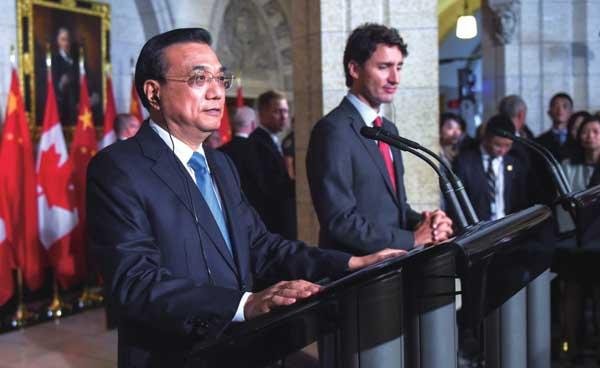BACK ON THE RIGHT TRACK
2016-05-14ByYuLintao
By Yu Lintao

After a decade-long estrangement between China and Canada, in less than a month, two productive and highly promising state visits have occurred. Shortly after Canadian Prime Minister Justin Trudeau touched down in China in late August, Chinese Premier Li Keqiang set foot on Canadian soil in September.
Considering that Trudeau has pursued an active engagement policy with China since assuming office last November, frequent bilateral interaction over the coming years would not come as a surprise. Some media commentators have described the re-warming of Sino-Canadian relations as“a rapid recovery” following a decade of cooling relations under Canadas previous administration.
Trudeaus China policy is rooted in the traditions of his Canadian Liberal Party, which has a record of maintaining friendly relations with China. When the party ruled Canada in 1970 under the stewardship of Pierre Trudeau, Justins father, the nation established official relations with China. However, the current prime minister is not merely following a previous party policy, since the international climate is constantly evolving, with China becoming increasingly central to the global economy. Enhancing economic connections with the worlds second largest economy has become ever more appealing to Canada, which is in need of fresh impetus to boost growth.
A favorable turn
Canadas decision to apply for membership of the Asian Infrastructure Investment Bank (AIIB) during Trudeaus China trip in late August was seen as a major indicator of its rekindled relationship with the country.
In spite of the U.S. call for the boycotting of the China-led multilateral financial institution, many of its allies such as Britain, Australia, Germany, and South Korea have nevertheless joined the bank as founding members.
Though it showed some interest in the AIIB, Ottawa gave up the chance to be a founding member due to heavy pressure from the United States, which sees the bank as a potential rival for the U.S.-dominated World Bank. So far, all G7 member countries have joined the bank except for the United States, Japan and Canada.
Yet, facing the impact of a meek global economic recovery and depressed international energy prices, Trudeau is fully aware of the necessity of engaging with China—one of the worlds major economic engines.
Professor Wang Yiwei, a researcher of international studies at the Beijing-based Renmin University of China, noted that if Canada wishes to grow its international market, expanding cooperation with China will be vital, rather than relying too heavily on the United States and EU markets. Canadas new administration has recognized the benefits of collaborating with China to boost its own economic growth, Wang told Beijing Review.
Bao Jianyun, another international studies professor with the same university, echoed professor Wang, adding that joining the AIIB can serve as a stepping stone for Canada to share in the economic growth potential of China.
Bao said that besides the vast Chinese demand for Canadian products and mineral resources, AIIB membership represents an opportunity for Canada to further engage in multilateral infrastructure projects that support inclusive growth in Asia and beyond, giving the North American country a new platform for investment overseas.
During a speech delivered at the CanadaChina Business Council in Shanghai, Trudeau noted candidly that “the success of the world is inexorably linked to Chinas success.”That trip resulted in 56 bilateral commercial deals in fields including energy, agriculture, infrastructure construction, transportation, and financial services.
The Chinese and Canadian economies are highly complementary in many areas and bilateral economic cooperation can bring widespread prosperity. For instance, as the worlds second largest country in size, Canada homes a comparatively small population of approximately 35 million. In comparison, China is the worlds most populous country, though with less than 10 percent of the worlds arable land, underlining the importance of agricultural cooperation.
Additionally, Ottawa has agreed to open seven additional visa application centers in China to help serve a growing number of Chinese tourists, which has risen thanks to the Asian countrys expanding middle-class.
During Premier Lis Canada visit, the two countries pledged to double bilateral trade by 2025. China is currently the nations second largest trading partner, behind the United States, with trade last year exceeding $64.5 billion. China also ranks second in terms of Canadas global export market, and as a source of imports.
A total of 14 cooperation agreements between the two countries were inked, covering trade, investment, finance, education, and tourism, etc. The two countries signed an agreement on the sharing and return of forfeited assets, a joint statement on cooperation in third party markets, a protocol to resume a broader range of Canadian beef exports (restrictions were imposed following the outbreak of bovine spongiform encephalopathy in Canada in 2003), and penned agreements on cooperation in combating crime and enhancing tourism. The two sides also pledged to end the lingering dispute surrounding Canadian canola oil exports by 2020.
Premier Li told journalists at a meeting in Ottawa, that along with broad common interests, he is confident that China and Canada will expand cooperation, deepen friendship, and enhance political mutual trust.
Coordination mechanism
Lis Ottawa trip also marked the formal launch of an annual dialogue mechanism to discuss security and the rule of law as well as economic and financial matters between the two heads of government that were established during Trudeaus China trip.
Zhang Junsai, the former Chinese Ambassador to Canada (2010-14), claimed that the mechanism is very helpful for maintaining a stable Sino-Canadian relationship.“Nothing can replace the importance of such face-to-face high-level meetings [in handling bilateral issues],” he said.
China has established similar dialogue platforms with many other nations, however, such an exchange with Canada has been rare over the past decade, noted Zhang. He added that the mechanism could spur a pro-ductive period in Sino-Canadian relations.
In an analytical article recently published on CRI (China Radio International) Online, Ma Yao, a researcher with Shanghai International Studies University, pointed out that the highlevel dialogue mechanism symbolizes the deepening of mutual trust between China and Canada. Moreover, during Lis visit, the two leaders also agreed to launch exploratory discussions for a possible Canada-China Free Trade Agreement (FTA)
Zhang explained that whilst working as the ambassador in Canada, he tried to advance negotiations on the China-Canada FTA, however the previous administrations cool attitude—led by Conservative Stephen Harper—toward China impeded progress. Moreover, many Canadians remain suspicious of free trade, despite the demand from Canadas economic circle. “Its not easy to begin FTA negotiation immediately, but it can be done step by step,” Zhang added.
A recent research report released by the Canada-China Business Council found that if China-Canada FTA negotiations were formally launched, Canadian investment abroad and exports will greatly increase and more skilled labor opportunities will be created.
When addressing the sixth Canada-China Business Forum in Montreal, Premier Li said,“Signing an FTA with Canada will be a challenge for China as it will have to bear greater pressure than the developed countries. However, China is willing to engage in FTA talks with Canada to press low-end domestic enterprises to move up the ladder.”
There have also been talks of an extradition treaty between the states, as Canada is a common destination for fleeing Chinese officials who are guilty of corruption—one quarter of Chinas 100 most wanted corruption suspects are said to be on Canadian soil, according to The Paper, a Chinese media.
Thanks to the efforts of officials between the nations, the Canadian Government has agreed to consider such a treaty with China. Nevertheless, it cannot be completed at the drop of a hat, since the Canadian opposition party tends to disagree, citing the existence of the death penalty in China.
During his visit, the Chinese premier maintained that the death penalty is consistent with Chinas national conditions and the ruling on the death penalty has been very strict. He emphasized to apply humanitarian treatment to convicted criminals. He urged the two sides to work together to cope with the common problems of todays world and bring tangible benefits to the people.
